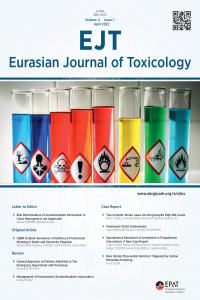Plasma Lactate Levels in Carbon Monoxide Intoxication, Can be Used at First Step?
Karboksihemoglobin, Karbonmonoksit, Laktat, Zehirlenme
Plasma Lactate Levels in Carbon Monoxide Intoxication, Can be Used at First Step?
Carboxyhemoglobin, Carbon monoxide, Lactate, Poisoning,
___
- 1. Satar S, Seydaoglu G, Akpinar A, Sebe A, Karakoc E, Gumusay U, et al. Trends in acute adult poisoning in a ten-year period in Turkey: factors affecting the hazardous outcome. Bratisl Lek Listy. 2009;110(7):404–11.
- 2. Kao LW, Nañagas KA. Carbon monoxide poisoning. Emerg Med Clin North Am. 2004;22(4):985-1018. doi:10.1016/j.emc.2004.05.003
- 3. Koylu R, Dundar ZD, Koylu O, Akinci E, Akilli NB, Gonen MO, et al. The experiences in a toxicology unit: a review of 623 cases. J Clin Med Res. 2014;6(1):59-65. doi:10.4021/jocmr1687w
- 4. Maloney G. Carbon monoxide. In: Tintinalli JE, editor. Tintinalli’s Emergency Medicine: A Comprehensive Study Guide. 7th ed. New York: McGraw-Hill; 2011. p. 1410–3.
- 5. Koruk S, Tuncel I, Mizrak A, Hengirmen Akcali A, Ganidagli S. Cerebrovascular changes and EEG findings in carbon monoxide intoxication: case report. J Emerg Med CASE REPORTS. 2010;1(2):23–6.
- 6. Smollin C, Olson K. Carbon monoxide poisoning ( acute ). BMJ Clin Evid. 2010;(June):1–12.
- 7. Weaver LK. Carbon Monoxide Poisoning. N Engl J Med. 2009;360(12):1217-25. doi:10.1056/NEJMcp0808891
- 8. Thom SR. Carbon monoxide pathophsyology and treatment. In: Neuman TS, Thom SR, editors. Phsyology and Medicine of Hyperbaric Oxygen Therapy. Philadelphia: Saunders/Elsevier; 2008. p. 321–47.
- 9. Cervellin G, Comelli I, Rastelli G, Picanza A, Lippi G. Initial blood lactate correlates with carboxyhemoglobin and clinical severity in carbon monoxide poisoned patients. Clin Biochem. 2014;47(18):298-301. doi:10.1016/j.clinbiochem.2014.09.016
- 10. Thom SR, Hampson NB, Mathieu-Nolf M, Raub JA. Carbon monoxide poisoning - a public health perspective. Toxicology. 2000;145(1):1-14. doi:10.1016/s0300-483x(99)00217-6
- 11. Benaissa ML, Megarbane B, Borron SW, Baud FJ. Is elevated plasma lactate a useful marker in the evaluation of pure carbon monoxide poisoning? Intensive Care Med. 2003;29(8):1372-5. doi:10.1007/s00134-003-1866-0
- 12. Jeong Mi Moon, Min Ho Shin, Byeong Jo Chun. The value of initial lactate in patients with carbon monoxide intoxication: in the emergency department. Hum Exp Toxicol. 2011;30(8):836-43. doi:10.1177/0960327110384527
- 13. Doğan N, Savrun A, Levent S, Günaydin GP, Çelik GK, Akküçük H, et al. Can initial lactate levels predict the severity of unintentional carbon monoxide poisoning? Hum Exp Toxicol. 2015;34(3):324-9. doi:10.1177/0960327114538986
- Yayın Aralığı: Yılda 3 Sayı
- Başlangıç: 2019
- Yayıncı: Acil Tıp Uzmanları Derneği
Acute Myocardial Infarction Following 5-Fluorouracil Use
Şükrü GÜRBÜZ, Muhammed EKMEKYAPAR, Hakan OĞUZTÜRK, Neslihan YÜCEL, M. Gökhan TURTAY, Serdar DERYA
Zehirlenmelerde Ekstrakorporeal Tedaviler
A Rare Cause of Serotonin Syndrome: Chronic Olanzapine Use
Seda DAĞAR, Emine EMEKTAR, Meral TANDOĞAN, Şeref Kerem ÇORBACIOĞLU, Hüseyin UZUNOSMANOĞLU, Yunsur ÇEVİK
Serdar ÖZDEMİR, Kamil KOKULU, Abdullah ALGIN, Hatice Şeyma AKÇA
Ticagrelor Intoxication: Overdose in a Suicidal Attempt
Sertaç GÜLER, Dilber ÜÇÖZ KOCAŞABAN
Evaluation of the Relationship of Serum Digoxin Levels with Demographic Data
Hatice Şeyma AKÇA, Abdullah ALGIN, Serdar ÖZDEMİR, Kamil KOKULU, İbrahim ALTUNOK
The Effects of Moon Phases on Suicide Attempts
Avni Uygar SEYHAN, Nihat Müjdat HÖKENEK, Nurhayat BAŞKAYA, Erdal YILMAZ, Semih KORKUT, Hatice Kübra ÖNDER KARAGÖZ, Huda ALMADHOUN
Plasma Lactate Levels in Carbon Monoxide Intoxication, Can be Used at First Step?
